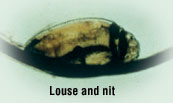
No-nit policies subject of debate
Another school year begins and so do questions about head lice
and school policies for children with nits.
by Tara Grassia
Staff Writer
September 2004
While “no-nit” policies are discouraged by some experts, others
recommend them as a public health standard intended to keep children
lice-free, nit-free and in school.
 “Without the no-nit policy,
communities are left with a hit-or-miss approach,” the National
Pediculosis Association (NPA)’s policy states. “Indifference about
adopting a standardized management protocol permeates the attitudes of
health professionals at every level.” “Without the no-nit policy,
communities are left with a hit-or-miss approach,” the National
Pediculosis Association (NPA)’s policy states. “Indifference about
adopting a standardized management protocol permeates the attitudes of
health professionals at every level.”
Those groups that discourage no-nit policies, such as the AAP and the
National Association of School Nurses (NASN), say that more can be done in
schools to prevent a child from missing what could be weeks of school.
“As a pediatrician who cares for children in both senses of the word,
for their health care and about them, I cannot agree with a no-nits
policy,” said Barbara Frankowski, MD, chair of the AAP Committee on School
Health. “To have a child miss school because of nits that don’t cause any
harm to anyone just doesn’t make sense.”
![[bar]](../images/gradient.gif)
For and against
Head lice infestation, or pediculosis capitis, tends to occur mostly
among children 3 to 12 years of age, according to the AAP. Approximately 6
to 12 million cases occur among U.S. schoolchildren annually.
Some schools have instituted no-nit policies, which mandate that all
students with nits or head lice be sent home from school until the nits or
lice are removed from the hair. The presence of nits or lice is used as a
marker for infestation, and some schools even require documentation of
treatment before students can return to school.
“Part of the no-nit policy reinforces the wrong message that the
schools are infested with the lice and that is the problem, when that is
not really where the focus of attention should be,” Frankowski told
Infectious Diseases in Children.
Absence from school means a loss in educational opportunity for the
student; however, the NPA believes readmitting an infested child is not
the solution.
“Education in advance of outbreaks, early detection and information on
the safe and effective alternative of screening will equip families to
effectively deal with head lice when they occur,” said Deborah Z.
Altschuler, president of the NPA.
While the AAP recommends manual removal of lice, nit comb use and
permethrin 1% as first-line therapy, resistance and possible adverse
effects have the NPA questioning this recommendation.
Altschuler told Infectious Diseases in Children that
chronic absenteeism for head lice is more “a reflection of reliance on
ineffective treatments and the lack of a sound prevention protocol.”
Frankowski suggested that proper use of a product such as permethrin,
even if not 100% effective, will decrease the live lice load and help
parents be more successful in picking out the lice and nits. Resistance
and adverse effects may be due to failure to follow directions; therefore,
it is important physicians review the treatment process with patients, she
added.
![[bar]](../images/gradient.gif)
Health consequences?
Frankowski said that today there are no health issues regarding head
lice besides itchiness and, rarely, superficial skin infection and skin
breakdown caused by irritating products and excessive scratching.
Frankowski believes part of the problem with no-nit policies is that
they are often created without scientific evidence to back them up.
“I always point out a child can go to school with a cold and no one
complains, yet the consequences of a cold are far worse than that of head
lice,” she said. “It doesn’t make sense; if you are going to have a
no-nits policy, you might as well have a ‘no runny nose’ policy, and it
would be just as ridiculous to try to do that.”
Despite differing opinions regarding no-nit policies, the AAP, NASN and
NPA agree that early detection plus teaching about prevention and
treatment can minimize head lice infestations among children.
Copyright 2004, SLACK Incorporated |